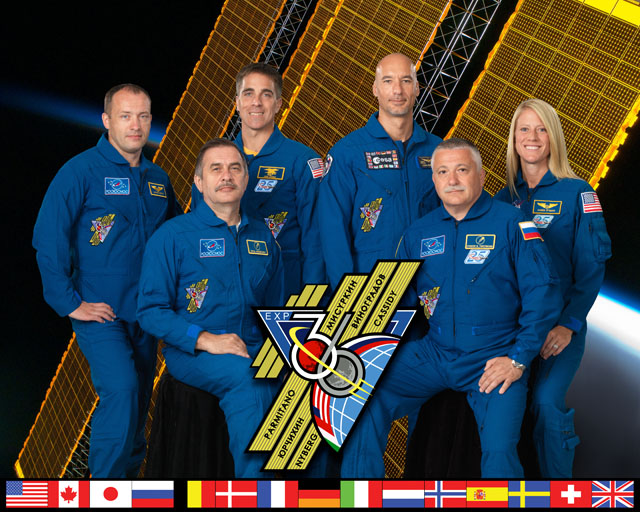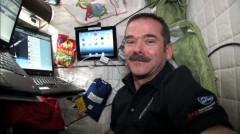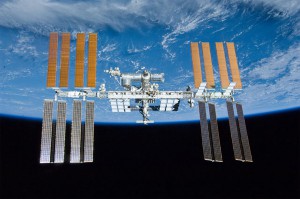
As fathers across the world receive greetings cards and gifts of electronics, tools, gadgets, shirts, and aftershave tomorrow, spare a thought for five dads who will spend Father’s Day away from their children, aboard the International Space Station. Expedition 36 Commander Pavel Vinogradov and Flight Engineers Aleksandr Misurkin, Chris Cassidy, Luca Parmitano, and Fyodor Yurchikhin have a combined 10 children between them, and Sunday’s occasion will undoubtedly be a time tinged with some sadness that they are so far away.
Vinogradov, Misurkin, and Cassidy have been away from home since 28 March, when they launched on Soyuz TMA-08M to form the second half of Expedition 35, under the leadership of Canada’s first ISS Commander, Chris Hadfield. Since the departure of Hadfield’s crew on 14 May, the trio has formed the core of Expedition 36. They were joined on 28 May by the incoming Soyuz TMA-09M crew, which included Yurchikhin, Parmitano, and NASA’s Karen Nyberg, who has a son of her own with husband and fellow astronaut Doug Hurley. Among them, Vinogradov and Cassidy each have three children, Yurchikhin has two, and Parmitano and Misurkin have one apiece.
Communications between the space station and their loved ones back on Earth is much easier today that it has been in yesteryear, but the sense of isolation remains a profound one. Shortly before his own launch to the ISS in December 2012, NASA astronaut Tom Marshburn noted that it would be difficult to miss watching his daughter open her presents on Christmas morning. Doubtless, Father’s Day will be no less difficult for Expedition 36’s five dads. Of course, the crew has access to email, which is updated by Mission Control in Houston, Texas, each day, and the station boasts an Internet Protocol (IP) phone to call family and friends whenever free time and available communications satellite coverage enables them to do so. They also have weekly private video conferences with their loved ones, often scheduled for weekends, when work duties are relatively light.

“The communication is really good,” said Chris Cassidy, who spent much time away from home in his pre-NASA military life as a Navy SEAL in Afghanistan and elsewhere. “In fact, I sometimes feel like I am more in touch with my family on the space station than when I was traveling back and forth to all the different training locations in the previous couple of years leading up to the flight.”
While the work of the Expedition 36 is intense—Cassidy’s mission features more than 200 discrete scientific experiments, supported by over 400 researchers on the ground—the crew is keenly aware of their inherent importance to improving life on Earth. The work includes medical observations, physical and materials science investigations, plant growth, and biology experiments and studies of small living creatures, including spiders.
There also remains the very real possibility that several Expedition 36 children may someday follow in their fathers’ footsteps. The world has already seen three “second-generation” spacefarers in recent years. Back in April 2008, Sergei Volkov—son of veteran cosmonaut Aleksandr Volkov—flew his first mission to the ISS. He was followed, in May 2009, by Roman Romanenko, whose father Yuri Romanenko set two empirical long-duration records aboard the Salyut 6 station in 1978 and Mir in 1987. Additionally, in October 2008, video game entrepreneur Richard Garriott flew to the ISS as a paying “space tourist.” Garriott is the son of former NASA astronaut Owen Garriott, who participated in missions aboard Skylab in 1973 and the shuttle in 1983.
Two years from now, NASA and Russia plan to send two men on a year-long expedition to the station and at least two Expedition 36 crew members are unsure as to whether they would be willing to sign up for such a lengthy mission. “I, at a personal level, wouldn’t mind,” admitted Cassidy in his pre-launch interview. “If NASA asked me to go, I would probably say yes, but it would certainly be with a lot of discussion inside my house.” Fyodor Yurchikhin was of a similar opinion. “Why not?” he rhetorically asked his interviewer. “Look at my hair! But first of all, I should ask my family.”

In past times, relationships between fathers and children have made for difficulty during space missions. Back in December 1972, Apollo 17 Commander Gene Cernan famously etched his daughter Tracy’s initials into the dust at the Taurus-Littrow valley on the Moon. Many have actively involved their children in the run-up to their missions: it was John Glenn’s children, Dave and Lyn, who proposed the name “Friendship 7” for the Mercury capsule aboard which he became the first U.S. astronaut to orbit the Earth. Others, including Gus Grissom—who died in the Apollo 1 launch pad fire in January 1967—once joked darkly that they were away so often that trips home served one primary function: to remind their children that they still had fathers!
That difficulty has extended in the opposite direction, too, when sons have been in orbit, separated from their fathers. Back in early 1978, Soviet cosmonaut Georgi Grechko was aboard the Salyut 6 space station when the news broke that his father had died. It was left to Grechko’s commander, Yuri Romanenko, to make the tough call to keep the news from him for the remainder of their three-month flight … and then break the news upon landing in mid-March. Soviet psychologists decreed that it was not appropriate to tell Grechko at the midpoint of his long mission and, years later, the cosmonaut agreed that the decision had been the right one to take.
Still other astronaut fathers found that their careers were directly or indirectly shaped by their children. Scott Carpenter made the decision to fly patrol aircraft, rather than become a fighter pilot, for the U.S. Navy, ahead of his selection as a member of the Mercury Seven. “His boyhood dream, held all through high school and beyond, was to be a fighter pilot,” wrote Carpenter and his daughter, Kris Stoever, in their book For Spacious Skies. Upon becoming a father, Carpenter’s “ego demanded he be a fighter pilot, but he remembered as a boy how he had hated being fatherless.” It has often been said that the death of Neil Armstrong’s daughter, Karen, may have helped to guide his steps from X-15 pilot to NASA astronaut and eventually to the Moon.
As five dads celebrate with their children tomorrow, let us spare a thought for the enormous sacrifices that both parties are willingly making for their loved ones. Vinogradov, Misurkin, Cassidy, Parmitano, and Yurchikhin will be flying more than 200 miles above their children’s heads—watching over them in a spiritual and literal sense—and perhaps the important work they are doing in 2013 will shape all of our futures.
Want to keep up-to-date with all things space? Be sure to “Like” AmericaSpace on Facebook and follow us on Twitter:@AmericaSpace



